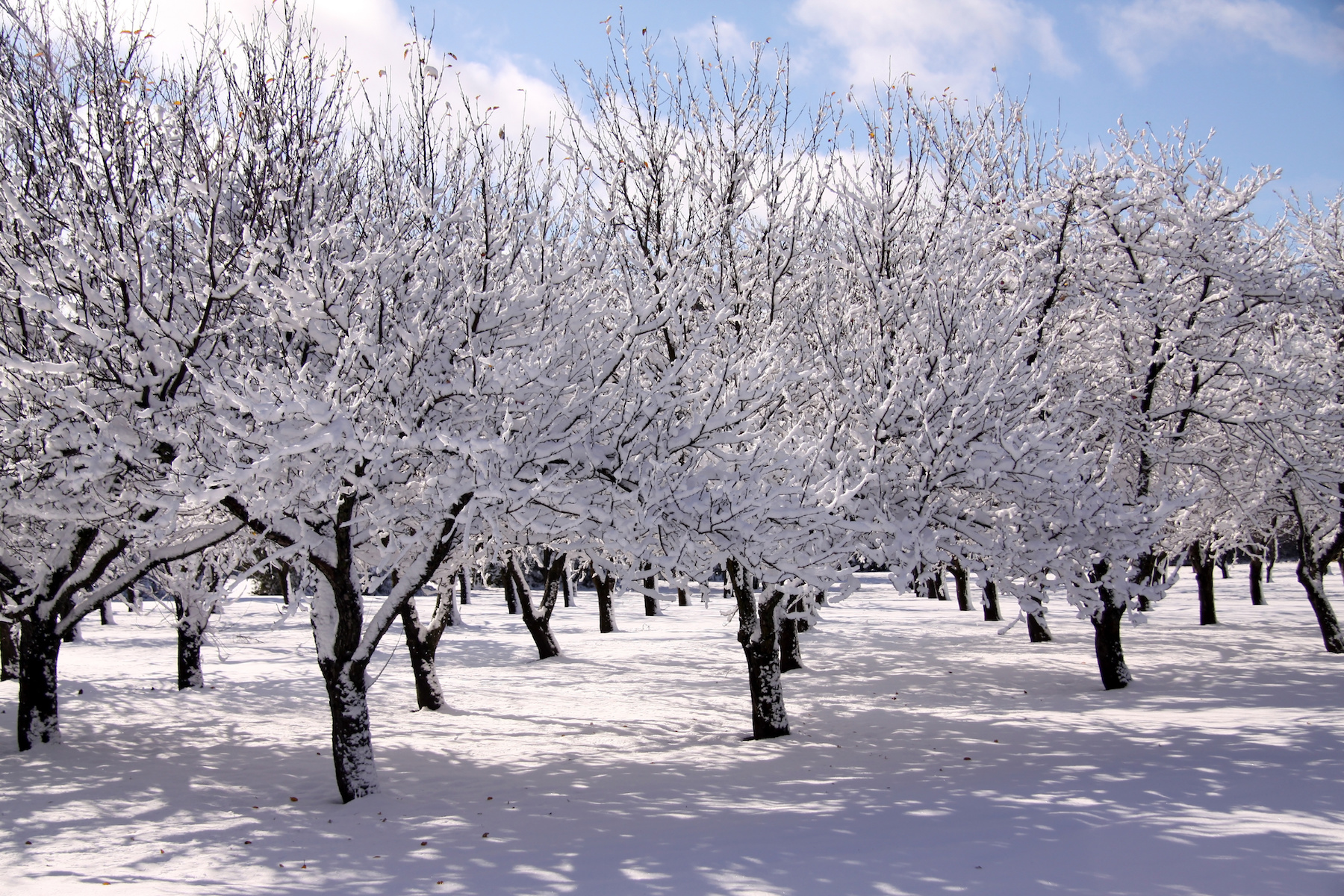Fall pruning can have long-lasting detrimenal effects on fruit tree cold hardiness. Today's blog post looks at how cold acclimation works, various research findings on how pruning affects cold hardiness, and best practices for growers for minimizing winter damage.
How Cold Acclimation Works
Cold acclimation is the process leading to the development of freezing tolerance in plants. Fruit trees, like other woody plants, gradually acclimate to low temperatures in the autumn in three stages. Autumn's shorter photoperiods trigger the onset of the first step of acclimation, a phase of warm weather pre-conditioning. The second stage occurs upon exposure to subfreezing temperatures later in the season, at which point trees experience rapid increases in hardiness. In fact, a tree may be as much as 10 degrees hardier the day after a frost than it was on the previous day. The final stage of acclimation occurs upon exposure to temperatures approaching 0˚F or -17.77˚C. At this point, maximum cold tolerance has been achieved.
Trees will remain hardy throughout the winter as long as temperatures remain fairly cold. De-acclimation will occur in response to warm temperatures, though trees can re-acclimate if these warm temperatures are swiftly followed by normal cold winter temperatures. Severe mid-winter cold snaps will fail to injure successfully acclimated trees, as long as they are not preceded by warm temperatures that begin the de-acclimation process. However, later in the winter, when the chilling requirement has been satisfied, trees begin to lose the ability to re-acclimate to hardiness levels obtained earlier in the winter, and may only partially re-acclimate.
Drs. Rich Marini and James Schupp, Professors of Horticulture and Pomology respectively at Penn State University, note that "cold hardiness" is a vague and often misleading term because low temperature injury can vary depending on when the low temperatures occur (early vs. mid or late winter), how fast the temperature drops, what the temperatures were during the previous few days, and how long the low temperatures are sustained. Therefore, the same plant may be affected differently by different cold events. The professors use the example of the peach rootstock 'Siberian C', which survives sub-zero temperatures in Ontario, Canada's consistently-cold winters but is killed at above zero temperatures in the Southern USA where winter temperatures fluctuate. 'Siberian C' is considered "cold hardy" in Ontario, but not in South Carolina.
How Pruning Affects Cold Acclimation and Cold Hardiness
Growers know that pruning early in the winter can reduce the cold hardiness of woody plants like fruit trees, but there have been few controlled experiments on the subject in the past. Those that have been conducted looked at how cold hardiness is affected by time of pruning, how long the pruning effect may last, and if pruning severity is involved.
Their findings are as follows:
- - Woody plants do not attain maximum cold hardiness when they are pruned in the fall.
- - Pruning in November tends to reduce the cold hardiness of woody plants until late February, so the effects of pruning are fairly long-lasting.
- - Pruning experiments with peaches show that fall-pruned trees had higher levels of the growth regulator indoleacetic acid (IAA). This is the naturally occurring auxin that is mimicked by the synthetic auxins that are used commercially, including NAA, 2,4,5-TP and 2,4-D.
- - Cambial activity (the tissue in the bark responsible for cell division contributing to trunk and stem radial growth) seems to be stimulated by the increased IAA levels following pruning. Peach tees pruned in November exhibited enhanced cambial activity in February.
- - Fall pruning puts peach trees at greater risk of peach tree short life (PTSL), a complex disorder of peach trees in the southeastern U.S. causing excessive mortality of trees less than 10-years old.
- - Recently pruned trees can be damaged when temperatures suddenly drop 50-60° degrees to 0°F or below. This increased sensitivity is greatest within 48 hours after pruning and gradually declines over a two week period.
Advice For Growers
- In conclusion, growers are advised to avoid pruning in late autumn and early winter, when fruit trees are not yet fully acclimated to tolerate cold temperatures. Pruning trees at this time can make them more sensitive to low temperature injury. It is best to wait until the trees have been exposed to freezing temperatures, and until the leaves have begun to turn yellow before beginning early dormant pruning. Also, keep a watchful eye on the long range forecast and suspend pruning when a severe drop in temperature is forecast to avoid damage.
Need a refresher on any of Croptracker's features? Head over to our Knowledge Base, where you'll find step-by-step tutorials as well as common troubleshooting tips and more. And as always, if you're ever stuck, never hesitate to e-mail us at support@croptracker.com or Live Chat with us by clicking the green speech bubble ![]() in your bottom right-hand corner. We're always happy to help you let Croptracker make your farm become more efficient, safe, and profitable!
in your bottom right-hand corner. We're always happy to help you let Croptracker make your farm become more efficient, safe, and profitable!
| Missed Last Week's Blog Post? Improving Hard Cider Quality With Crop Load Management |


